Overview of surfing in Great Ocean Road
Overview of surfing on the Great Ocean Road
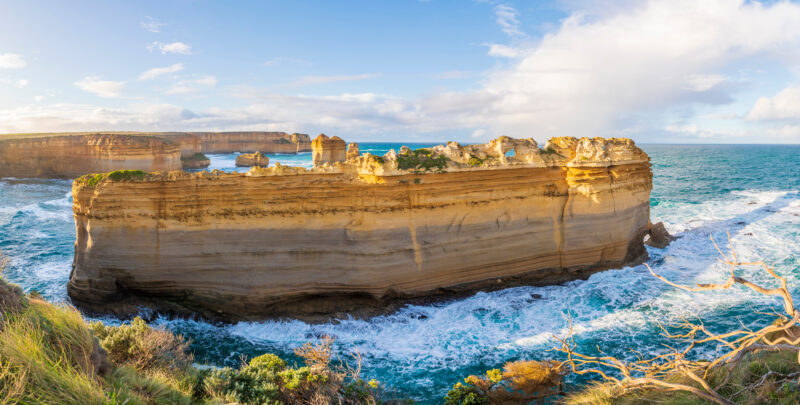
The Great Ocean Road is one of Australia’s most legendary coastal stretches — a winding clifftop highway that hugs dramatic headlands, limestone stacks, lush rainforest, rolling farmland, and some of the most iconic surf breaks on Earth. Running from Torquay to Warrnambool, this coastline is a blend of raw Southern Ocean power and laid-back Victorian surf culture. As a national heritage site, the Great Ocean Road holds immense significance within the country of Australia, serving as a major scenic route that showcases the region’s natural beauty. It is also recognised as the world’s largest war memorial, underscoring its global importance. The route stands out as one of Australia’s most iconic natural attractions, drawing visitors from around the globe.
This region sits directly in the firing line of Southern Ocean swell, receiving powerful long-period waves year-round. Winter brings heavy, pumping surf and consistent groundswells, while summer delivers clean mornings, mellow beach breaks, and playful longboard days. The water is cold, the winds are often wild, and the ocean here has a reputation for being powerful, moody, and unforgiving — but also breathtakingly beautiful and insanely rewarding. The Great Ocean Road serves to connect a series of vibrant coastal towns, renowned surf spots, and spectacular natural landmarks, making it a vital link for both locals and visitors.
Torquay marks the start of the Road — the true home of Australian surf culture, where Rip Curl and Quiksilver were born, wetsuit innovation began, and the iconic Bells Beach found its place as one of the world’s most celebrated right-hand pointbreaks. The beginning of the Great Ocean Road integrates seamlessly with other major routes, making it a convenient entry point for travelers. As you travel further, the coastline becomes more rugged and remote, with long beaches, rock shelves, hidden reefs, dreamy coves, and quiet towns that feel untouched by time. The road makes even the most secluded surf spots accessible to visitors of all abilities, opening up the region’s natural wonders to everyone.
Whether you’re a beginner looking for a scenic longboard-friendly bay or an advanced surfer chasing powerful reef slabs and historic right-handers, the Great Ocean Road delivers a cinematic surf adventure like no other.
Surf Regions on the Great Ocean Road
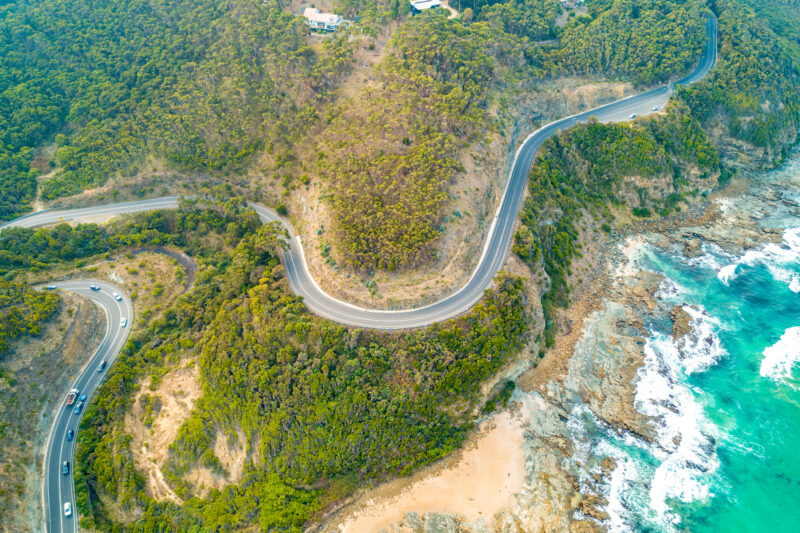
Torquay & Surf Coast (Torquay, Jan Juc, Bells Beach)
Aussie surf capital with pointbreak perfection, wetsuit heritage, and world-famous waves.
Anglesea & Aireys Inlet
Fun, user-friendly beaches mixed with tricky reefs and empty, scenic lineups.
Lorne & Surrounds
Beautiful sheltered bays, longboard-friendly points, and dreamy beginner conditions. Teddy’s Lookout is a must-visit scenic site here, offering panoramic views of the coastline.
Apollo Bay & Otways Region
Open beaches with powerful surf, scenic headlands, and vast stretches of untouched coastline. The region is home to notable sites like the Marengo Reefs Marine Sanctuary, popular with visitors for its unique marine life.
Cape Otway to Johanna
Raw, exposed beaches with huge power — a big-wave and advanced-surfer zone.
Port Campbell & The Twelve Apostles Coastline
Heavy slabs, reef breaks, and serious power in a dramatic limestone setting. The Twelve Apostles is a world-renowned site, drawing visitors to its iconic rock formations.
Warrnambool & Port Fairy
User-friendly beach breaks, fun points, and mellow regional surf energy.
The Great Ocean Road traverses Victoria’s south west coast, renowned for its scenic beauty, rugged landscapes, and historical significance.

Getting there
The Good
- Year-round swell
- Iconic right-hand points
- Variety for all skill levels
- Spectacular scenery
- Rich surf history
- Consistent cold-water performance waves
- Uncrowded beaches once you leave Torquay
- Opportunity to explore diverse surf breaks, stunning landscapes, and local attractions along the Great Ocean Road
The Bad
- Cold water all year
- Local crowds at top spots
- Powerful surf + strong rips
- Winds can switch fast
- Winter = big swell + heavy conditions
- Remote sections have limited facilities
Getting There and Access
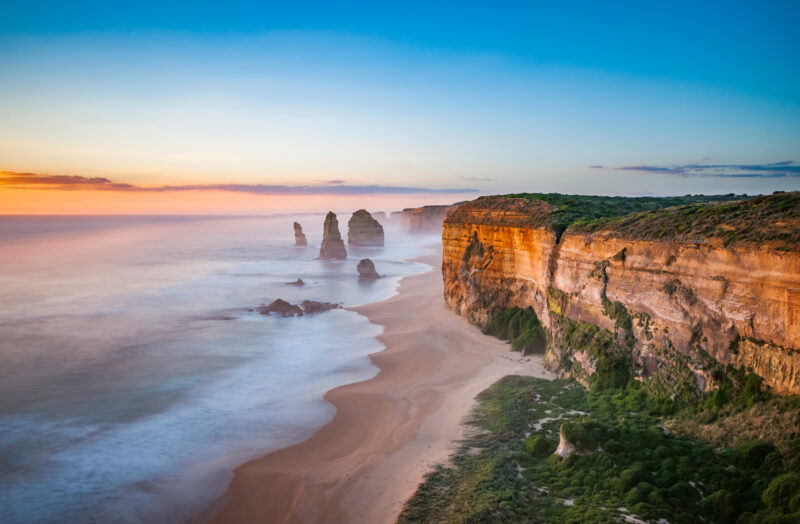
Fly into Melbourne (Tullamarine or Avalon).
Torquay is about 1–1.5 hours from the city.
Public transport options, including train services and connecting buses, are available from Melbourne to reach the Great Ocean Road. Real-time schedules for trains can help you coordinate your journey from the city to nearby towns.
The Great Ocean Road is fully driveable, with endless surf pull-offs, parking bays, and track access points.
A car or campervan is 100% essential.
Some breaks require rock hops, reef entries, or longer walks.
For the best experience, plan your trip by checking current road conditions, possible closures, and public transport schedules. Our advice is to always prepare ahead to ensure a safe and smooth journey.
Crowds
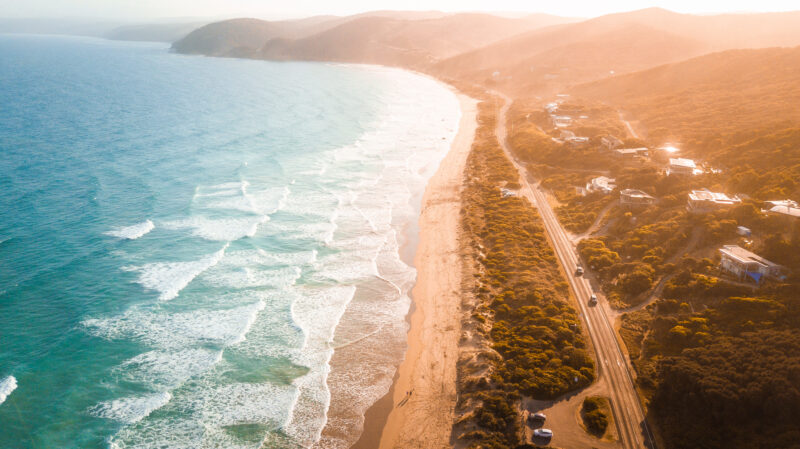
Torquay and Bells: heavy
Jan Juc: moderate
Anglesea: light to moderate
Lorne: varies by season
Johanna + Otways region: often empty
Port Campbell westward: very light
Cold water and strong swell keep crowds down compared to other Aussie coasts.
Lineup Lowdown
Surf etiquette is strong on the Surf Coast:
- Don’t paddle straight to the top of a point
- Locals know the reefs — be respectful
- Rotate waves at Bells + Winki
- Don’t surf heavy reefs beyond your ability
- Smile + say g’day — people are friendly but proud
The further west you go, the more relaxed the lineups become.
Surf seasons and when to go
The best time of the year to surf in Great Ocean Road
Surf Seasons and When to Go
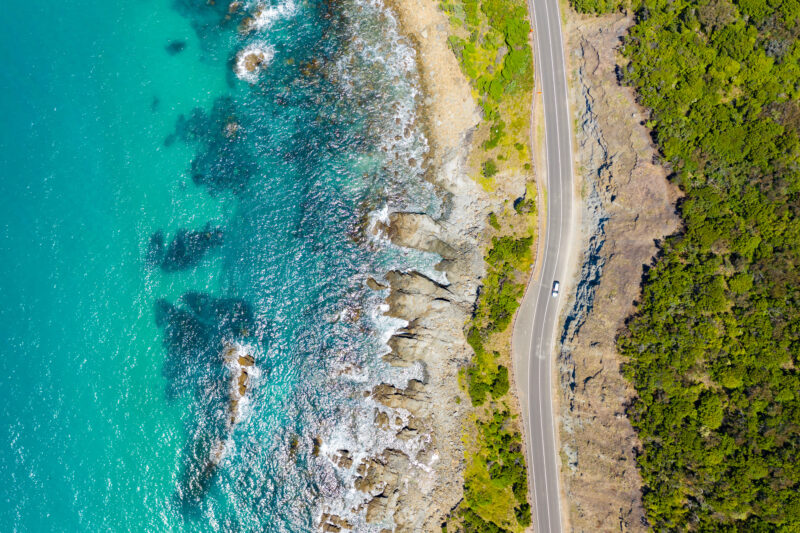
Autumn (March–May):Prime season. Clean offshore mornings, warm days, strong swell. Bells is at its best.
Winter (June–Aug):Huge Southern Ocean swells. Cold, powerful, consistent surf. Advanced surfers thrive. August often features commemorative events and memorial dedications along the Great Ocean Road, marking historical milestones.
Spring (Sept–Nov):Windy but fun. Changing banks, playful days, cool temps.
Summer (Dec–Feb):Smaller surf but clean. Great for beginners + cruisy vibes. Early mornings are key. December marks important milestones, such as the passing of the Great Ocean Road Protection Act and the completion of major construction phases.
Water Temperatures and Weather
Water temps:
Winter: 12–14°C
Summer: 16–18°C
Wetsuits:
Winter: 4/3 or 5/4 with booties
Summer: 3/2
Weather:
Winter: cold, windy, stormy
Summer: warm, calm mornings, seabreezes
Bring layers — the Surf Coast is known for four seasons in one day.
Can’t-Miss Surf Spots
Bells Beach
The crown jewel of Australian surfing. A long, powerful right-hand point with multiple sections including Rincon, The Bowl, and Winki Pop. Known for its smooth walls, carving potential, and iconic Easter Rip Curl Pro. Bells handles massive swell and remains one of the most reliable big-wave points in the world.
Winki Pop
Adjacent to Bells, Winki Pop is a faster, more technical right-hand point with long running walls that reward advanced surfers. The takeoff zone is tight and competitive, but the pay-off is a world-class ride when the lines stack perfectly.
Torquay Front Beach & Point Danger
Gentle beach break with soft waves ideal for beginners and longboarders. Torquay is the birthplace of Aussie surf culture and a great place to learn or warm up before hitting the heavier reefs.
Jan Juc
A consistent beach break that offers punchy peaks and fun walls for intermediates and advanced surfers. Works well on all tides and offers more space than Bells.
Anglesea
A mix of gentle beach breaks and trickier reefs. Anglesea Main Beach is popular with beginners, while secret reefs toward Point Roadknight offer fun, clean waves on quiet mornings.
Point Roadknight
A sheltered longboard-friendly right-hand point that works on small swells. Perfect for beginners, families, and cruisy logging sessions.
Lorne Point
A long, scenic right-hand point that works best during big easterly swells. When it turns on, it becomes one of the most beautiful rides on the entire coast — long walls, mellow takeoffs, and pure flow.
Apollo Bay
An open beach offering playful peaks on small days and powerful, challenging surf on larger swells. Great for intermediates who want to push themselves.
Johanna Beach
A raw, exposed beach known for heavy, powerful surf and consistent swell. When Bells is too small, Johanna often pumps. Strong rips, big walls, and punchy conditions — advanced surfers’ playground.
Wreck Beach
A remote, scenic beach with a steep descent and wild surf. Good for solitude and heavier winter challenges.
Port Campbell
A reef-and-beach combo zone surrounded by limestone cliffs. Can deliver long walls and hollow sections when conditions align.
Warrnambool – Logan’s Beach
Fun beach break with playful walls and good longboard potential. Known for whale watching in winter.
Port Fairy
A mellow longboard-friendly coastline with fun peaks and a peaceful small-town surf culture.
When visiting these surf spots, please respect and protect the local environment to help preserve these beautiful locations for future generations.
Great Ocean Road surf travel guide
Find trips that fit a flexible lifestyle
Learning to Surf on the Great Ocean Road
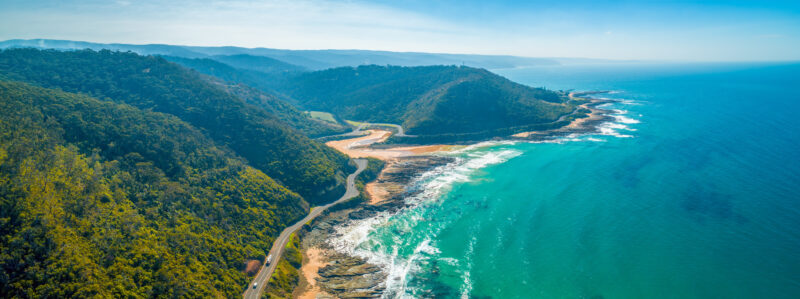
Best beginner beaches:
- Torquay Front Beach
- Anglesea Main Beach
- Lorne Main Beach
- Point Roadknight
- Apollo Bay (small days)
- Warrnambool
Lessons: AU$40–80
Board hire: AU$20–40/day
In addition to lessons and board hire, surf tours and guided experiences are available for beginners who want to explore the region with expert instruction.
The region is great for learners in summer, but winter is generally too heavy.
Safety and Etiquette
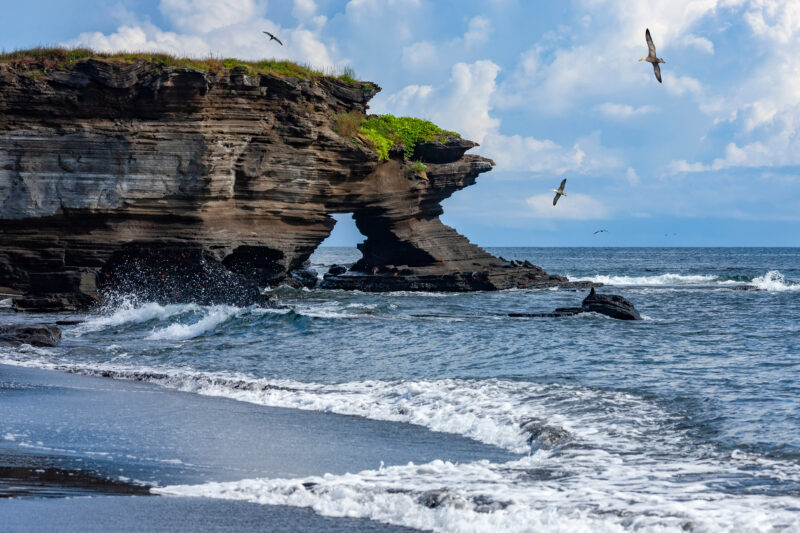
- Strong rips on open beaches
- Sharp reefs at Bells, Winki, Jan Juc
- Cold water — hypothermia risk in winter
- Rapid weather changes
- Remote areas have no lifeguards
- Wildlife including seals and occasional sharks
- Stay within your skill level — the Southern Ocean is powerful
Respect the lineup and you’ll fit right in.
The responsibility for managing safety and infrastructure along the Great Ocean Road falls to the relevant authorities, such as VicRoads.
Surf and Yoga Retreats
Most retreats are located near:
- Torquay
- Jan Juc
- Anglesea
- Lorne
- Apollo Bay
Packages include surf coaching, yoga, ocean mindfulness, nature walks, and coastal accommodation. Prices: AU$800–2,500 per week.
Many retreats also host special events such as wellness workshops or seasonal gatherings.
Accommodation Options for Surfers
Budget: AU$40–80 (hostels + campgrounds)
Mid-range: AU$100–200 (motels + cabins)
Boutique stays: AU$200–450
Luxury cliff houses: AU$400–1,000+ per night
Caravan parks are everywhere and super popular for van-lifers.
Comparison to Other Surf Destinations
Great Ocean Road vs Gold Coast:
- Heavier, colder, more powerful
- Less crowded but more raw
- More scenic + dramatic
Great Ocean Road vs Margaret River:
- Similar power
- More sheltered beginner options
- Colder overall
Great Ocean Road vs New Zealand:
- More variety packed into a smaller region
- More historic surf culture
Exploring the Great Ocean Road offers a unique experience, with diverse surf spots, stunning landscapes, and vibrant local culture to discover along the way.
It’s one of the best cold-water surf adventures on the planet.
Expenses (AUD)
Accommodation: AU$40–500+
Food: AU$15–30
Lessons: AU$40–80
Board hire: AU$20–40
Fuel: moderate to high
National parks: AU$0–15
Costs vary depending on season + location.
Money from tourism and government funding is essential for maintaining and developing the Great Ocean Road, ensuring it remains accessible and safe for visitors.
Cultural Notes
Expect:
- Proud Victorian surf culture
- Friendly, earthy locals
- Café culture in Torquay + Lorne
- Roadside bakeries (pie heaven)
- The chance to taste local produce, regional specialties, and join food experiences like chocolate workshops or degustation menus
- Long coastal hikes
- Wetsuits everywhere
- Afternoon seabreezes
It’s classic Aussie coastal living — relaxed but ocean-savvy.
Cell Coverage & Wi-Fi
Strong around major towns
Weak in remote cliffs and Otways area
Wi-Fi common in cafés and hotels
Final Thoughts
The Great Ocean Road is one of the most iconic surf coastlines in the world — a place where stunning scenery meets powerful Southern Ocean swell, world-famous right-hand pointbreaks, and a surf history that runs deep. From the carved walls of Bells Beach to the playful peaks of Jan Juc, longboard-friendly waves at Lorne, raw heaviness at Johanna, and quiet perfection in hidden coastal pockets, this region offers something for every surfer.
It’s rugged, beautiful, unpredictable, and deeply rewarding. Whether you’re chasing the legacy of Bells, road-tripping through the Otways, longboarding in sheltered bays, or embracing the cold-water stoke, surfing the Great Ocean Road is a rite of passage for any Australian or visiting surfer.
A coastline full of power, beauty, heritage, and pure Aussie magic.


